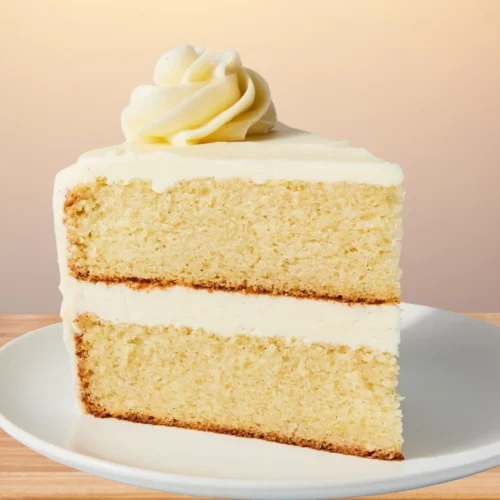
Reverse Creaming Vanilla Cake
Reverse creaming vanilla cake uses an unconventional mixing method where dry ingredients are mixed with butter before adding wet ingredients. This creates a tender, tight crumb and flat top, ideal for layer cakes. The technique helps reduce gluten development, ensuring a moist, dense texture while maintaining rich vanilla flavor and structural stability. Perfect for decorating.
Equipment
- Stand mixer or hand mixer
- Mixing bowls
- Measuring cups & spoons
- Sifter or fine-mesh sieve
- Rubber spatula
- 2 x 9-inch cake pans
- Cooling rack
- Offset spatula (for frosting)
- Parchment paper
Ingredients
For the Vanilla Cake:
- 2½ cups 312g all-purpose flour
- 1¾ cups 350g granulated sugar
- 1 tbsp baking powder
- ½ tsp salt
- ¾ cup 170g unsalted butter, room temperature, cut into small cubes
- 4 large eggs room temperature
- 1 cup 240ml whole milk, room temperature
- ¼ cup 60ml sour cream or plain Greek yogurt
- 1 tbsp pure vanilla extract
For the Vanilla Buttercream Frosting:
- 1 cup 227g unsalted butter, softened
- 4 cups 480g powdered sugar, sifted
- ¼ cup 60ml whole milk or heavy cream
- 2 tsp pure vanilla extract
- ¼ tsp salt
Instructions
Step 1: Prep Your Equipment and Ingredients
- Start by preheating your oven to 350°F (175°C). Grease two 9-inch cake pans and line them with parchment paper for easy release. For best results, bring your milk, eggs, and butter to room temperature before you begin.
Step 2: Sift and Mix Dry Ingredients
- In a large mixing bowl, sift together the flour, granulated sugar, baking powder, and salt. Whisk briefly to make sure everything is evenly combined.
Step 3: Add Butter to Dry Mix (Reverse Creaming)
- Drop the cubed, room-temperature butter straight into the dry mixture. Using a stand mixer with the paddle attachment (or a hand mixer), beat on low speed until the mixture looks like coarse, sandy crumbs. This reverse creaming method helps coat the flour with butter, keeping the cake tender and soft.
Step 4: Combine Wet Ingredients
- In another bowl, whisk together the milk, sour cream (or yogurt), eggs, and vanilla extract until smooth and well blended.
Step 5: Add Wet Ingredients in Stages
- With your mixer on low speed, slowly pour in half of the wet mixture. Increase the speed to medium and beat for about 1 minute until the batter looks light and fluffy. Gradually add the remaining wet ingredients and mix until just combined. Be careful not to overmix here.
Step 6: Pour and Smooth the Batter
- Divide the batter evenly between the prepared cake pans. Use a spatula to gently smooth the tops for even baking.
Step 7: Bake the Cake
- Place the pans in your preheated oven and bake for 30–35 minutes, or until a toothpick inserted into the center comes out clean. If you’re making cupcakes instead, they’ll bake in about 18–22 minutes.
Step 8: Cool Completely
- Let the cakes rest in their pans for 10 minutes before carefully turning them out onto a wire rack. Allow them to cool completely before adding frosting.
Step 9: Make the Vanilla Buttercream
- In a large bowl, beat the softened butter on medium speed for about 3 minutes until creamy. Slowly add sifted powdered sugar, one cup at a time, mixing well after each addition. Then pour in the milk (or cream), vanilla, and a pinch of salt. Beat on high for another 2–3 minutes until the buttercream is light, fluffy, and smooth.
Step 10: Frost the Cake
- Once your cakes are completely cool, spread or pipe the vanilla buttercream as desired. Layer, swirl, and decorate to your heart’s content!
Notes
Room temperature ingredients ensure better emulsion and smoother batter. The reverse creaming method gives the cake a tighter, velvety crumb great for layered cakes that need structure. Sour cream or Greek yogurt adds moisture and richness, but it’s optional. Be careful not to overmix the batter after adding the eggs.
Nutrition Facts Of Reverse Creaming Vanilla Cake
| Nutrition | Amounts |
|---|---|
| Calories | 520 |
| Fat | 27g |
| Saturated Fat | 16g |
| Cholesterol | 120mg |
| Sodium | 210mg |
| Carbohydrates | 66g |
| Sugar | 47g |
| Protein | 5g |